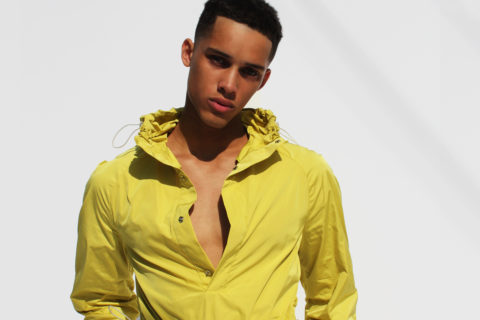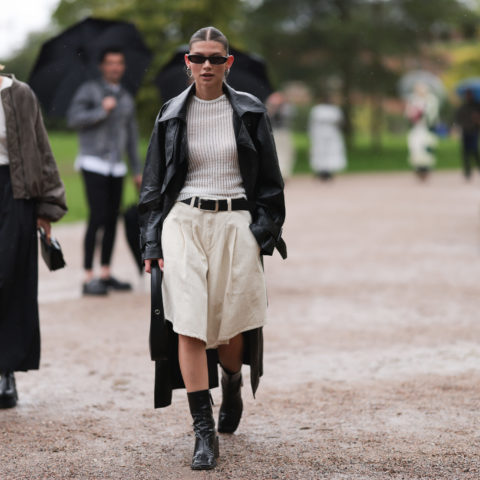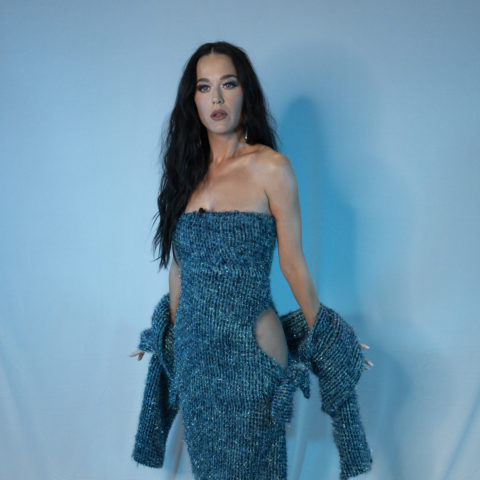Andrew Coimbra Talks Recycled Fabrics and Genderless Options for Spring 2021
Expect deliberately fresh pops of colour and silhouettes inspired by fine art.
If you’re ready to start fantasizing about your Spring 2021 wardrobe, Toronto’s Andrew Coimbra has options for all. When it comes to dressing, the designer’s instincts have manifested in an array of thoughtful pieces that nod to the work of artists including Pierrette Bloch and Jean (Hans) Arp; think flowing lines mixed with a tailored refinement, finished with idiosyncratic details. We caught up with Coimbra to talk about the forthcoming offerings, his design ethos–which includes ungendered considerations and working with recycled and deadstock materials, and what he’s optimistic about as we look to the future.
The new collection is beautiful. What about Arp and Bloch’s work inspired you this season?
My first love, and skill set, was always in the visual arts–drawing and painting, with a side of sculpture. When I was more heavily in that realm of creativity, while studying at OCADU, I was always drawn to works by artists like Pierrette Bloch, Jean (Hans) Arp and Henry Moore, to name a few. Visually, I really enjoy the organic quality of their work, and more specifically how it often feels like a perfected organic, if that makes sense.
When looking to develop the Spring 2021 collection, I wanted to create something that of course had a superficial beauty to it, but a beauty that came from something that felt organic and real. Bloch’s collection of works use materials typically thought of as ‘sans frills’, and her hand style is very loose and natural. When I found the cotton and silk-blended shirting the can be seen on mainly the ready-to-wear pieces, I was immediately reminded of her 1990 piece, ‘Sans Titre’.
On the other hand, Arp’s sculptural pieces are smooth, refined, often polished versions of an organic idea. The lines and layers in his work were a great source of inspiration when thinking about developing pieces that had transformative properties to them, and that echoed the core lines of the body.

Tell me about the fabrics used in the pieces–in particular, the recycled polyester.
In my sourcing process, I happened upon a company that has a pretty great selection of recycled polyester materials that also offers custom printing. The manufacturer transforms PET, or polyethylene terephthalate–say that ten times fast–bottles into threads to weave into bolts of fabric. It is then blended with a new-production polyester thread, which I suspect is done for a couple of different reasons including the water resiliency of a particular fabric that I’ve used, as well as to ensure that any custom-printing is long term. It’s a really cool fabric, and it’s promising to know that these sorts of technologies are being applied in a practical way.
With the exception of the recycled polyester blend items, I tried to focus on using mostly natural or natural blend materials like silks, cottons, ramie, linen, mohair, wool. It was important for me to focus on natural materials not only to balance out the synthetics used, but to echo the organic inspiration, to keep the collection feeling luxurious and refined, and of course in hopes of not wanting to amplify or be party to any potential waste pollution through manufacturing. It is hard to avoid as a smaller label, but it’s something I try to consider when sourcing.
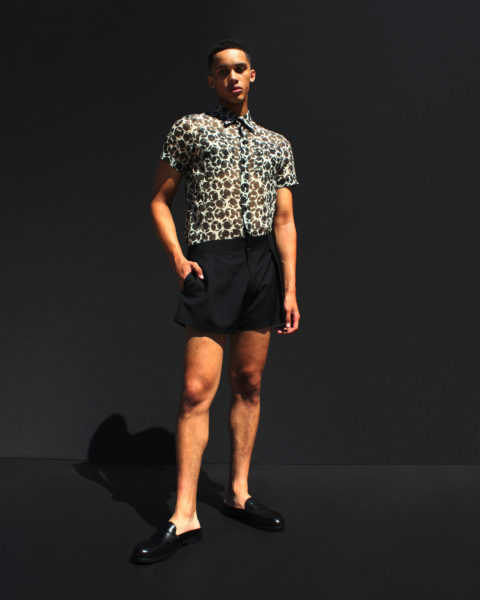
Why is it important for you to use deadstock and recycled fabrics in your collections?
Since the inception of my brand, I have always sourced from and used deadstock fabric. It has always been a forefront thing for the label for a plethora of reasons, all centred around being mindful of the space I have in my studio, limiting waste, and being economical.
Using recycled fabric was important to me because I felt like it is representative of myself as an individual, in addition to as a designer. I believe in the power of recycling, and think that as individuals we should all be conscious of how we contribute to global waste. I’m certainly not perfect, and I don’t think I will ever be a person who will collect and convert my shower water into drinking water or whatever that character on Netflix’s The Politician does, but I like to think I do my part!
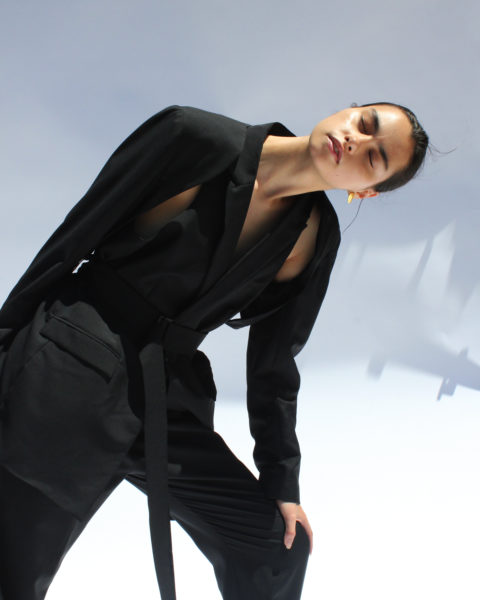
What’s one of your favourite pieces in the collection and why?
I think my favourite pieces in the new season are a firm tie between the convertible blazer from the genderless collection–made of a blend of wool, mohair, and silk–and the asymmetric wrap top from the ready-to-wear collection, made of a cotton and silk-blend shirting fabric.
The convertible blazer is great not only because it’s particularly unique as a concept; the idea has been around for decades, but largely in the womenswear sphere. As someone who has always shopped both departments–because I like options, hello–it’s important for me to design things that are available for those who identify as men to shop and enjoy, that don’t just fall into the long-standing idea of what is acceptable for men. This piece I think fully represents the ethos of the genderless line. There are also really great design details, like the curved back element of the detachable bolero, the super-long sleeve vent with eight horn buttons, and the stirrup-style side hem with belt loops that secure it to the vest with the belt.
The asymmetric wrap top is just really beautiful. I designed it as a cool updated take on similar styles that cropped up in the 1970s that kind of allude to this feeling of being on a holiday. The asymmetric curved style detail along the bust has become what I like to think of as a signature detail for the ready-to-wear collection, and it’s largely due to the influence of the works of Arp, Moore, [Isamu] Noguchi and [Pierre] Paulin in my designs.
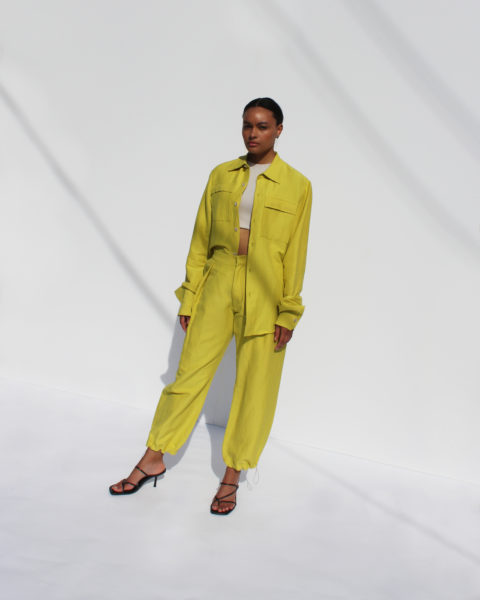
It sounds like your creative juices were really flowing in conceiving these pieces; how are you staying optimistic right now?
It might seem crazy to say, but I don’t think it’s too difficult to stay optimistic right now. As wild and uncertain as the news has been lately, there are just as many truly inspiring moments. All of the initiatives by individuals and companies that have surfaced because of insecurities highlighted by the COVID-19 pandemic have been refreshing and heartwarming; it’s a great testament to the power of a global community.
And the All Black Lives Matter movement, which ultimately gave birth to this discussion around Defunding the Police–which has shed light on gaps in social assistance, including education and healthcare systems and programs–are all the start of a necessary discussion about priorities, humanity, and how we value each other. All this to say, I’m looking forward to things not “going back to normal”, but to things being better in the near future–and a time when we can feel as good as we look.

